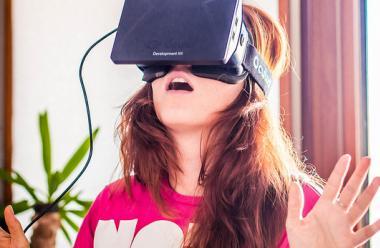Recently I helped organise a digital marketing event called DA University 2015 which included a number of tech demonstrations that proved very popular with the audience of marketers. This got me thinking about the key tech developments that all marketers should know about for 2015:
OCULUS RIFT
One of the technologies which has been making headlines recently is Oculus Rift. You may have heard of its recent purchase by Facebook for $2 billion, a move which left many eagerly awaiting to see how Facebook intends to develop and apply this technology, expectation only enhanced by Mark Zuckerberg's description of the VR device as 'the future of The Internet' at the time of the purchase. Facebook's move will almost certainly expand interest in it beyond the US military and more dedicated members of the gaming community, for whom it has largely been confined to for the last two decades.
Created by Californian teenager, Palmer Luckey, Oculus Rift was developed initially as a gaming device which is now beginning to find greater use across a number of sectors. In Japan, real estate developers are already making use of Virtual Reality headsets to allow customers to test the designs for their houses before they begin construction. The Daiwa House, based in Tokyo, has created a Try Lab in which consumers can experience and interact with the interiors of the houses they intend to have built.
At this year's DA University our Creative Director Ryan Bousfield developed an experience inspired by our client Massey Ferguson's support of an expedition to the South Pole using one of their tractors. The experience allowed users to see the MF1560 tractor in the context of the Antarctic, giving a taste of the conditions in which the product will be operating. These applications, allowing users to be transported to harsh, distant and inhospitable climates opens up the possibility for Oculus Rift to communicate commercial activities which have thus far been fraught with technological difficulties, and best left to the imagination.
Wrigley's have been amongst the first to make use of its technology with their Unit9 film, simulating flight, augmenting the user suspended in harnesses. Another notable recent project, by the England Rugby Team, is titled Follow the Rose and makes use of the technology to implant the viewer in the midst of the action of the England Rugby Team.
iBEACONS
Of all the technologies currently under development, the iBeacon is the one likely to have the greatest impact on people's lives in the near future. An indoor positioning system developed by Apple, the iBeacon - when implanted into a object - is able to determine its position within a room, and as a part of the growing Internet of Things has potential scope to be built into a variety of objects and products. By 2020 it is predicted that all products over $50 (£30) will be connected in this way to the Internet. This prediction heralds an enormous expansion in the potential of the internet, from connecting people and communities, to connecting ever-increasing amounts of the physical world. Though this expanding digital infrastructure faces challenges, including how to make the enormous data generated by a world of objects communicating with each other valuable to companies, and further, how to make this useful to the consumer.
A number of tech giants from Microsoft to Google are experimenting with positioning systems, which unlock and expand on the potential created by scalable cloud computing, the increased presence of Wi-Fi and low power processors. Early experiments with this technology have shown its wide potential, from waste management systems, to monitoring and providing parking solutions. Though its in its use to marketers, through synchronizing content pushed to people's mobiles based on their location in-store, through in-store notifications and giving us information about consumer preferences where the enormous potential remains to be unlocked.
APPLE WATCH
The launch of the Apple Watch in early 2015 will the most important milestone so far if not ever in the development of the Wearable Tech market.
Much of the debate around Apple's iWatch, is centred on its sociological implications, and how it changes our engagement with tech. As Apple has developed such a consistent and ubiquitous approach to design and functionality that many can't imagine them departing from, much of the expectant potential in the iWatch lies in how it will change a device we are already so familiar with. Its biggest change is heralding a greater integration between computers and ourselves. Reducing the barriers between technology and us which runs alongside the trend to reduce the barriers to sharing data.
Much of the marketing potential in the watch centres around biometrics, using its contact with skin to enable use, authorise payments, and measure our body’s data. It is in this area, related to human health where much of the potential watch is felt. For marketers, it is the challenge of adapting to greater human and technological integration.
The relationship between technology and marketing is becoming increasingly important and I believe that 2015 will be a key and pivotal year.
Sean Singleton is the managing director of Digital Annexe. @DigitalAnnexe
Read more from him in our Clubhouse.
Newsletter
Enjoy this? Get more.
Our monthly newsletter, The Edit, curates the very best of our latest content including articles, podcasts, video.
Become a member
Not a member yet?
Now it's time for you and your team to get involved. Get access to world-class events, exclusive publications, professional development, partner discounts and the chance to grow your network.

